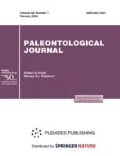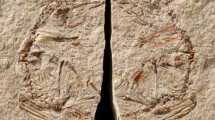Abstract
Enantiornithes is the most speciose clade of Cretaceous birds, but many taxa are known from isolated postcranial skeletons. Two embryonic enantiornithine bird skeletons of Gobipipus reshetovi gen. et sp. nov. from the Upper Cretaceous (Campanian) Barun Goyot Formation of the Gobi Desert in Mongolia provide new insights into the anatomy, radiation, and mode of development of early avialans. In recent times, both enantiornithine and ornithuromorph birds are known from the Barun Goyot Formation as well as from the Djadokhta and Nemegt Formations. The 80-million-year-old Gobipipus skeletons encased within eggshells shows several features characteristic of enantiornithine birds. The wing skeleton and shoulder girdle show morphological features indicating that Gobipipus achieved sophisticated powered flight. Gobipipus reshetovi gen. et sp. nov. is quite distinct from the sympatric enantiornithine species Gobipteryx minuta from the same strata in many anatomical features. Phylogenetic analysis of 26 avialan ingroup taxa based on distribution of 202 characters indicate that Gobipipus is a basal member of enantiornithine birds along with Confuciusornis and shares more characters with ornithuromorphs than previously recognized. The embryonic nature of Gobipipus specimens sheds new light on the developmental history of enantiornithine birds. The well-ossified bones of the fore- and hind limbs, and fusion of many skeletal elements indicate a precocial mode of development in Gobipipus. Apparently Gobipipus hatchlings could walk away from the ground nests as soon as they emerged from their eggs. The asymmetry of egg poles are unique features of Gobipipus eggs (oogenus Gobioolithus) among Cretaceous avialans. The microstructure of the shell in Gobioolithus eggs with the embryos of Gobipipus is typical avian (of ornithoid basic type) and less ratite-like in morphology of the spongy layer than is that in the other possible egg-remains of enantiornitine birds (oofamily Laevisoolithidae).
Similar content being viewed by others
References
Alvarenga, H.M.F. and Bonaparte, J.F., A new flightless land bird from the Cretaceous of Patagonia, in Papers in Avian Paleontology, Honoring Pierce Brodkorb, Campbell, K.E., Ed., Natur. Hist. Mus. Los Angeles County Sci. Ser., 1992, no. 36, pp. 51–64.
Bellairs, A.D’A. and Jenkin, C.R., The skeleton of birds, in Biology and Comparative Physiology of Birds, Marshall, A.J., Ed., New York: Academic Press, 1960, vol. 1, pp. 241–300.
Carpenter, K., Eggs, Nests, and Baby Dinosaurs, Bloomington: Indian University Press, 1999.
Chatterjee, S., The Rise of Birds, Baltimore: Johns Hopkins University Press, 1997.
Clarke, J.A. and Norell, M.A., The morphology and phylogenetic position of Apsaravis ukhaana from the Late Cretaceous of Mongolia, Am. Mus. Novitates, 2002, no. 3387, pp. 1–46.
Clarke, J.A. and Norell, M.A., New avialan remains and a review of the known avifauna from the Late Cretaceous Nemegt Formation of Mongolia, Am. Mus. Novitates, 2004, no. 3447, pp. 1–12.
Clarke, J.A., Zhou, Z., and Zhang, F., Insight into the evolution of avian flight from a new clade of Early Cretaceous ornithurines from China and the morphology of Yixianornis grabaui, J. Anat., 2006, vol. 208, pp. 287–308.
Chiappe, L.M., Late Cretaceous birds of southern South America: anatomy and systematics of Enantiornithes and Patagopteryx deferariisi, Munch. Geowissensch. Abhundl., 1996, vol. 30, pp. 203–244.
Chiappe, L.M., The Chinese early bird Confuciusornis and the paraphyletic status of “Sauriurae”, J. Vertebr. Paleontol., 1997, vol. 17, no. 3, pp. 37A.
Chiappe, L.M., Late Cretaceous birds of southern South America: anatomy and systematics of Enantiornithes and Patagopteryx deferariisi, Munch. Geowissensch. Abhundl., 1996, vol. 30, pp. 203–244.
Chiappe, L.M., Glorified Dinosaurs, Sydney: University of New South Wales, 2007.
Chiappe, L.M., Norell, M., and Clark, J., A new skull of Gobipteryx minuta (Aves: Enantiornithes) from the Cretaceous of the Gobi Desert, Am. Mus. Novitates, 2001, no. 3346, pp. 1–15.
Chiappe, L.M. and Walker, C.A., Skeletal morphology and systematics of the Cretaceous Enantiornithes (Ornithothoraces: Enantiornithes), in Mesozoic Birds, Chiappe, L.M. and Witmer, L.M., Eds., Berkeley: University of California Press, 2002, pp. 240–280.
Cracraft, J., The origin and early diversification of birds, Paleobiol., 1986, vol. 12, pp. 383–399.
Elzanowski, A., Preliminary note on the palaeognathous bird from the Upper Cretaceous of Mongolia, Palaeontol. Polon., 1974, no. 30, pp. 103–109.
Elzanowski, A., Palaeognathous bird from the Cretaceous of Central Asia, Nature, 1976, vol. 264, no. 5581, pp. 51–53.
Elzanowski, A., Skulls of Gobipteryx (Aves) from the Upper Cretaceous of Mongolia, Palaeontol. Polon., 1977, no. 37, pp. 153–165.
Elzanowski, A., Embryonic bird from the Late Cretaceous of Mongolia, Palaeontol. Polon., 1981, no. 42, pp. 147–179.
Elzanowski, A., The evolution of parental care in birds with reference to fossil embryos, Acta XVIII Int. Ornithol. Congr., 1985, vol. 1, pp. 178–183.
Elzanowski, A., Cretaceous birds and avian phylogeny, Cour. Forsch. Senck., 1995, vol. 181, pp. 37–53.
Gradzinski, R. and Jerzykiewicz, T., Sedimentation in Barun Goyot Formation, Palaeontol. Polon., 1974, no. 30, pp. 111–146.
Horner, J.R. and Weishampel D.B., A comparative embryological study of two ornithischian dinosaurs, Nature, 1988, vol. 332, pp. 256–257.
Hou, L., Zhou, Z., Martin, L.D., and Feduccia, A., A beaked bird from the Jurassic of China, Nature, 1995, vol. 377, pp. 616–618.
Hou, L., Martin, L.D., Zhou, Z., and Feduccia, A., Early adaptive radiation of birds: evidence from fossils from northeastern China, Science, 1996, vol. 274, pp. 1164–1167.
Hou, L., Martin, L.D., Zhou, Z., and Feduccia, A., Archaeopteryx to opposite birds-missing link from the Mesozoic of China, Vertebr. PalAsiat., 1999, vol. 37, pp. 88–95.
Kielan-Jaworowska, Z. and Barsbold, R., Narrative of the Polish-Mongolian paleontological expeditions 1967–1971, Palaeontol. Polon., 1972, no. 27, pp. 5–16.
Kurochkin, E.N., A new enantiornithid of the Mongolian Late Cretaceous, and a general appraisal of the infraclass Enantiornithes (Aves), Paleontol. Inst. Russian Acad. Set, Spec. Issue, Moscow: Palaeontological Institute, 1996, pp. 1–55.
Martin, L.D., The origin and early radiation of birds, in Perspectives in Ornithology, Brush, A.H. and Clark, G.A., Jr., Eds., Cambridge: Cambridge University Press, 1983, pp. 291–338.
Martin, L.D., The Enantiornithes: Terrestrial birds of the Cretaceous, Cour. Forsch. Senck., 1995, vol. 181, pp. 23–36.
Mikhailov, K.E., Classification of fossil eggshells of amniotic vertebrates, Acta Palaeontol. Polon., 1991, vol. 36, pp. 193–238.
Mikhailov, K.E., The microstructure of avian and dinosaurian eggshell: phylogenetic implications, in Papers in Avian Paleontology, Honoring Pierce Brodkorb, Campbell, K.E., Jr. and Campbell, K.E., Ed., Natur. Hist. Mus. Los Angeles County Sci. Ser., 1992, no. 36, pp. 361–373.
Mikhailov, K.E., Eggs of birds in the Cretaceous of Mongolia, Paleontol. Zhurn., 1996, vol. 30, no. 1, pp. 114–116.
Mikhailov, K.E., Fossil and Recent Eggshells in amniotic vertebrates: fine structure, comparative morphology and classification, Special Papers Paleontol., 1997a, no. 56, p. 80.
Mikhailov, K.E., Avian eggshells: an atlas of scanning electron micrograph, Br. Ornithol. Club, Occasional Publ., 1997b, no. 3, p. 88.
Mikhailov, K.E., Sabath, K., and Kurzanov, S.M., Eggs and nests from the Cretaceous of Mongolia, in Dinosaur Eggs and Babies, Carpenter, K., Hirsch, K.F., and Horner, J., Eds., Cambridge: Cambridge University Press, 1994, pp. 88–115.
Novacek, M., Dinosaurs of the Flaming Cliff, New York: Doubleday, 1996.
Sabath, K., Upper Cretaceous amniotic eggs from the Gobi Desert, Acta Palaeontol. Polon., 1991, vol. 36, pp. 151–192.
Sanz, J.L. and Buscalioni, A.D., A new bird from the Early Cretaceous of Las Hoyas, Spain, and the early radiation of birds, Palaeontol., 1992, vol. 35, pp. 829–845.
Sanz, J.L., Chiappe, L.M., Perez-Moreno, B.P., Buscaloni, A.D., Moratalla, J.J., Ortega, F., and Poyato-Aroza, F.J., An early Cretaceous bird from Spain and its implications for the evolution of avian flight, Nature, 1996, vol. 383, pp. 442–445.
Shuvalov, V.F., The lake bassins of the arid and humid regions of Mongolia in the Late Mesozoic, in Mezozoiskie Ozernie Basseiny Mongolii, Martinson, G.G., Ed., Leningrad: Nauka, 1985, pp. 39–61.
Sochava, A.V., Dinosaur egg from the Upper Cretaceous of the Gobi Desert, Paleontol. Zhurn., 1969, no. 4, pp. 517–527.
Starck, J.M., Zeitmuster der Ontogenesen bei nestflüchttenden und nesthockenden Vögeln, Cour. Forsch. Senck., 1989, vol. 114, pp. 1–319.
Starck, J.M., Evolution of avian ontogenies, in Current Ornithology, Power, D.M., Ed., New York: Plenum Press, 1993, vol. 10, pp. 275–366.
Starck, J.M. and Sutter, E., Patterns of growth in megapodes: prolonged incubation permits superprecocial chicks, J. Ornithol., 1994, vol. 135, pp. 85.
Walker, C.A., New class of birds from the Cretaceous of South America, Nature, 1981, vol. 292, pp. 51–53.
Xu, X., You, H., Du, K., and Han, F., An Archaeopteryx-like theropod from China and the origin of Avialae, Nature, 2011, vol. 475, pp. 465–470.
Zhang, F. and Zhou, Z., A primitive enantiornithine bird and the origin of feathers, Science, 2000, vol. 290, pp. 1955–1959.
Zhang, F., Zhou, Z., Hou, I.l, and Gu, G.l, Early diversification of birds: evidence from anew opposite bird, Chin. Sci. Bull., 2001, vol. 46, pp. 945–949.
Zhou, Z. and Zhang, F., A beaked basal ornithurine bird (Aves, Ornithurae) from the Lower Cretaceous of China, Zool. Scr., 2006, vol. 35, pp. 363–373.
Author information
Authors and Affiliations
Corresponding author
Additional information
The article is published in the original.
Rights and permissions
About this article
Cite this article
Kurochkin, E.N., Chatterjee, S. & Mikhailov, K.E. An embryonic enantiornithine bird and associated eggs from the cretaceous of Mongolia. Paleontol. J. 47, 1252–1269 (2013). https://doi.org/10.1134/S0031030113110087
Received:
Published:
Issue Date:
DOI: https://doi.org/10.1134/S0031030113110087




